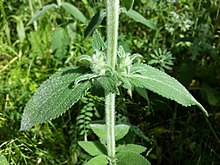German Ziest
| German Ziest | ||||||||||||
|---|---|---|---|---|---|---|---|---|---|---|---|---|

German ziest ( Stachys germanica ) |
||||||||||||
| Systematics | ||||||||||||
|
||||||||||||
| Scientific name | ||||||||||||
| Stachys germanica | ||||||||||||
| L. |
The German ziest ( Stachys germanica ) is a species of the mint family (Lamiaceae). It blooms from June to September.
description
Vegetative characteristics
The German Ziest usually grows as a biennial herbaceous plant and reaches heights of 40 to 125 centimeters. It is a semi-rosette plant. The stem is often branched and, like the whole plant, appears gray-white due to its thick, fine, silky hair.
Of the opposite leaves on the stem, the lower ones are clearly stalked, the upper ones - especially the bracts - sessile. The simple leaf blades are egg-shaped-elliptical with a notched leaf margin with a length of 3 to 10 centimeters and a width of 1 to 5 centimeters.
Generative characteristics
The inflorescence consists of dense and rich-flowered, about 16 to 20 flowers comprehensive pseudo whorls , which are densely packed in the upper part. The hermaphroditic flowers are 12 to 18 millimeters long, zygomorphic and five-fold with a double flower envelope . The calyx is densely haired with silky hair, the calyx teeth are spiky and clearly protruding from the felt. The petals are light carmine-red in color and fade when drying; outside they are hairy long, silky-shaggy.
The Klausen are about 2 to 2.5 millimeters long, triangular, smooth and blackish in color.
The number of chromosomes is 2n = 30.
Occurrence
Stachys germanica occurs from the Mediterranean area to the Danube countries, Central Europe and southern England. It penetrates further into the Carpathian Mountains and Southwest Asia. As a new citizen he can also be found in Canada. In Austria it is rare in the Pannonian region , otherwise very rarely to be found. In Switzerland it occurs scattered.
The German Ziest occurs only very scattered in Germany. It is more common, especially in the southern part of the area. It is missing in the northwest and northeast of Germany.
The German Ziest grows in semi-arid grass, in light bushes, on embankments, in quarries and on rubble. It prefers more or less dry, nutrient-rich and often calcareous soils. In Central Europe it is a character species of the Onopordion acanthii association, but also occurs in Mesobromion societies.
Systematics
The first publication of Stachys germanica was done by Carl von Linné .
The following subspecies can be distinguished from Stachys germanica :
- Stachys germanica subsp. dasyanthes (Raf.) Arcang. : It occurs in Italy and Sicily .
- Stachys germanica subsp. germanica : It occurs from Europe to the Caucasus , but also on the Canary Islands and in northwest Africa .
- Stachys germanica subsp. heldreichii (Boiss.) Hayek : It occurs from the Balkan Peninsula to Transcaucasia .
- Stachys germanica subsp. velezensis (Sagorski) Hayek : It occurs on the northwestern Balkan Peninsula.
literature
- Gustav Hegi : Illustrated flora of Central Europe. 1975, Paul Parey publishing house, Berlin and Hamburg, ISBN 3-489-78021-3
- Christian August Friedrich Garcke : Illustrated flora. 1972, Paul Parey Publishing House, ISBN 3-489-68034-0 .
- Wolfgang Adler, Karl Oswald, Raimund Fischer: Excursion flora of Austria. Ed .: Manfred A. Fischer . Ulmer, Stuttgart / Vienna 1994, ISBN 3-8001-3461-6 .
- August Binz , Christian Heitz: School and excursion flora for Switzerland. 1986, Schwabe & Co. AG, Basel, ISBN 3-7965-0832-4
- Erich Oberdorfer : Plant-sociological excursion flora. 1990, Ulmer Verlag, Stuttgart, ISBN 3-8001-3454-3
Individual evidence
- ↑ a b Erich Oberdorfer : Plant-sociological excursion flora for Germany and neighboring areas . With the collaboration of Angelika Schwabe and Theo Müller. 8th, heavily revised and expanded edition. Eugen Ulmer, Stuttgart (Hohenheim) 2001, ISBN 3-8001-3131-5 , pp. 807-808 .
- ↑ a b c d e f Rafaël Govaerts (Ed.): Stachys germanica. In: World Checklist of Selected Plant Families (WCSP) - The Board of Trustees of the Royal Botanic Gardens, Kew . Retrieved February 20, 2016.
Web links
- German Ziest. In: FloraWeb.de.
- German Ziest . In: BiolFlor, the database of biological-ecological characteristics of the flora of Germany.
- Stachys germanica L. In: Info Flora , the national data and information center for Swiss flora . Retrieved February 20, 2016.
- Thomas Meyer: Ziest data sheet with identification key and photos at Flora-de: Flora von Deutschland (old name of the website: Flowers in Swabia ).





